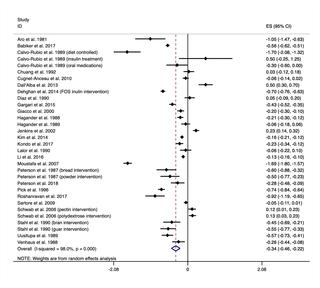PLOS Medicine ( IF 10.5 ) Pub Date : 2020-03-06 , DOI: 10.1371/journal.pmed.1003053 Andrew N Reynolds 1, 2 , Ashley P Akerman 1, 3 , Jim Mann 1, 2

|
Background
Fibre is promoted as part of a healthy dietary pattern and in diabetes management. We have considered the role of high-fibre diets on mortality and increasing fibre intake on glycaemic control and other cardiometabolic risk factors of adults with prediabetes or diabetes.
Methods and findings
We conducted a systematic review of published literature to identify prospective studies or controlled trials that have examined the effects of a higher fibre intake without additional dietary or other lifestyle modification in adults with prediabetes, gestational diabetes, type 1 diabetes, and type 2 diabetes. Meta-analyses were undertaken to determine the effects of higher fibre intake on all-cause and cardiovascular mortality and increasing fibre intake on glycaemic control and a range of cardiometabolic risk factors. For trials, meta regression analyses identified further variables that influenced the pooled findings. Dose response testing was undertaken; Grading of Recommendations Assessment, Development and Evaluation (GRADE) protocols were followed to assess the quality of evidence. Two multicountry cohorts of 8,300 adults with type 1 or type 2 diabetes followed on average for 8.8 years and 42 trials including 1,789 adults with prediabetes, type 1, or type 2 diabetes were identified. Prospective cohort data indicate an absolute reduction of 14 fewer deaths (95% confidence interval (CI) 4–19) per 1,000 participants over the study duration, when comparing a daily dietary fibre intake of 35 g with the average intake of 19 g, with a clear dose response relationship apparent. Increased fibre intakes reduced glycated haemoglobin (HbA1c; mean difference [MD] −2.00 mmol/mol, 95% CI −3.30 to −0.71 from 33 trials), fasting plasma glucose (MD −0.56 mmol/L, 95% CI −0.73 to −0.38 from 34 trials), insulin (standardised mean difference [SMD] −2.03, 95% CI −2.92 to −1.13 from 19 trials), homeostatic model assessment of insulin resistance (HOMA IR; MD −1.24 mg/dL, 95% CI −1.72 to −0.76 from 9 trials), total cholesterol (MD −0.34 mmol/L, 95% CI −0.46 to −0.22 from 27 trials), low-density lipoprotein (LDL) cholesterol (MD −0.17 mmol/L, 95% CI −0.27 to −0.08 from 21 trials), triglycerides (MD −0.16 mmol/L, 95% CI −0.23 to −0.09 from 28 trials), body weight (MD −0.56 kg, 95% CI −0.98 to −0.13 from 18 trials), Body Mass Index (BMI; MD −0.36, 95% CI −0·55 to −0·16 from 14 trials), and C-reactive protein (SMD −2.80, 95% CI −4.52 to −1.09 from 7 trials) when compared with lower fibre diets. All trial analyses were subject to high heterogeneity. Key variables beyond increasing fibre intake were the fibre intake at baseline, the global region where the trials were conducted, and participant inclusion criteria other than diabetes type. Potential limitations were the lack of prospective cohort data in non-European countries and the lack of long-term (12 months or greater) controlled trials of increasing fibre intakes in adults with diabetes.
Conclusions
Higher-fibre diets are an important component of diabetes management, resulting in improvements in measures of glycaemic control, blood lipids, body weight, and inflammation, as well as a reduction in premature mortality. These benefits were not confined to any fibre type or to any type of diabetes and were apparent across the range of intakes, although greater improvements in glycaemic control were observed for those moving from low to moderate or high intakes. Based on these findings, increasing daily fibre intake by 15 g or to 35 g might be a reasonable target that would be expected to reduce risk of premature mortality in adults with diabetes.
中文翻译:

糖尿病管理中的膳食纤维和全谷物:系统评价和荟萃分析。
背景
纤维被推广为健康饮食模式和糖尿病管理的一部分。我们考虑了高纤维饮食对死亡率的影响,以及增加纤维摄入量对糖尿病前期或糖尿病成人血糖控制和其他心脏代谢危险因素的影响。
方法和结果
我们对已发表的文献进行了系统回顾,以确定前瞻性研究或对照试验,这些研究或对照试验研究了在不额外饮食或其他生活方式改变的情况下,较高纤维摄入量对患有前驱糖尿病、妊娠期糖尿病、1 型糖尿病和 2 型糖尿病的成人的影响。进行荟萃分析以确定较高纤维摄入量对全因死亡率和心血管死亡率的影响,以及增加纤维摄入量对血糖控制和一系列心脏代谢危险因素的影响。对于试验,荟萃回归分析进一步确定了影响汇总结果的变量。进行了剂量反应测试;遵循建议评估、制定和评价分级 (GRADE) 协议来评估证据的质量。两个由 8,300 名患有 1 型或 2 型糖尿病的成年人组成的多国队列平均随访了 8.8 年,并确定了 42 项试验,其中包括 1,789 名患有糖尿病前期、1 型或 2 型糖尿病的成年人。前瞻性队列数据表明,在研究期间,将每日膳食纤维摄入量 35 克与平均摄入量 19 克进行比较,每 1,000 名参与者的死亡人数绝对减少 14 人(95% 置信区间 (CI) 4-19)。明显的剂量反应关系。增加纤维摄入量可降低糖化血红蛋白(HbA1c;33项试验的平均差[MD] -2.00 mmol/mol,95% CI -3.30至-0.71)、空腹血糖(MD -0.56 mmol/L,95% CI -0.73至-0.38,来自 34 项试验),胰岛素(标准化均数差 [SMD] -2.03,95% CI -2.92 至 -1.13,来自 19 项试验),胰岛素抵抗的稳态模型评估(HOMA IR;MD -1.24 mg/dL,95% CI -1.72 至 -0.76,来自 9 项试验),总胆固醇(MD -0.34 mmol/L,95% CI -0.46 至 -0。27 项试验中的 22 项)、低密度脂蛋白(LDL)胆固醇(MD -0.17 mmol/L,95% CI -0.27 至 -0.08 21 项试验)、甘油三酯(MD -0.16 mmol/L,95% CI -0.23 至-0.09,来自 28 项试验),体重(MD -0.56 kg,95% CI -0.98 至 -0.13,来自 18 项试验),体重指数(BMI;MD -0.36,95% CI -0·55 至 -0·16)与低纤维饮食相比,来自 14 项试验)和 C 反应蛋白(SMD -2.80,95% CI -4.52 至 -1.09,来自 7 项试验)。所有试验分析均存在高度异质性。除了增加纤维摄入量之外的关键变量是基线纤维摄入量、进行试验的全球区域以及糖尿病类型以外的参与者纳入标准。潜在的局限性是缺乏非欧洲国家的前瞻性队列数据,以及缺乏增加成人糖尿病患者纤维摄入量的长期(12 个月或更长)对照试验。
结论
高纤维饮食是糖尿病管理的重要组成部分,可改善血糖控制、血脂、体重和炎症指标,并降低过早死亡率。这些益处并不局限于任何纤维类型或任何类型的糖尿病,并且在各种摄入量范围内都很明显,尽管从低摄入量转向中量或高摄入量的人在血糖控制方面观察到了更大的改善。基于这些发现,将每日纤维摄入量增加 15 克或至 35 克可能是一个合理的目标,有望降低成人糖尿病患者过早死亡的风险。











































 京公网安备 11010802027423号
京公网安备 11010802027423号